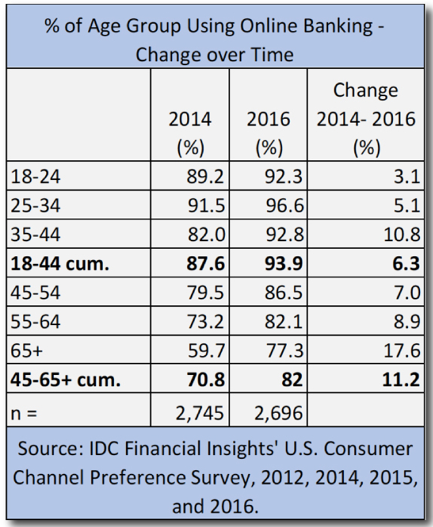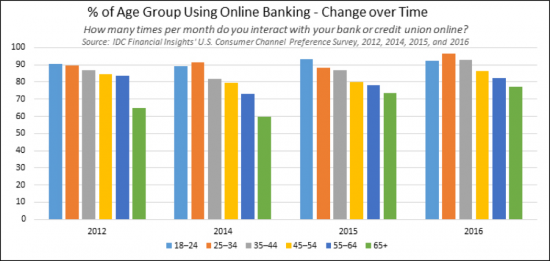Many years ago, my family used to drive to our local community bank to cash checks, make deposits, and pay bills. My grandmother would wait in a longer line to see her favorite teller. My grandfather developed a close relationship with the loan officer, who also helped several family friends buy a car or a home. They didn’t visit the bank every day, but they were loyal customers most of their lives.

Today, things look a little different. Consumers are spending less time in physical bank branches—but they’re interacting more often with banking products and services. In fact, analyst firm IDC predicts that the number of bank-client interactions will increase by a factor of four in the next five years because of the Internet of Things (IoT) and the continued digitization of the consumer.1
Even though consumers may be using a smartphone instead of chatting with their favorite teller, they still expect a personalized banking experience. They’re looking for more convenient, timely, and digital-first online banking services. How can you meet those high expectations—for customers of all ages—in the digital era?
What recent shifts in digital behavior mean for banks

According to the IDC Financial Insights’ U.S. Consumer Channel Preference Survey2, over 64% of consumers are interacting with banks via online channels either on a weekly or daily basis. Although almost 64% of Americans still prefer to open an account in a branch, that number is down eight percent since 2015.
On the other hand, the number of Americans who prefer to open an account via mobile channels increased 67% between 2015 and 2016. Those who prefer online channels increased by 12% year to year.
The caveat is that it wasn’t Millennials driving these rising numbers. While the highest percentage of younger consumers continue their use of online and mobile channels, these segments have seen little growth. Actually, from 2014 to 2016, nearly twice as many banking consumers ages 45-65 increased their use of online banking at twice the rate of those ages 18-44 (11.2% vs. 6.3%)3. Consumers over age 65 increased their online banking usage by 17.6%–followed by 10.8% for ages 35-44, and 8.9% for ages 55-64. Consumers ages 18-34 held their usage relatively steady in comparison, with a growth in usage of 3.1-5.1%.

Older consumers’ rapid adoption of online banking indicates how integral digital is to both financial services and the American lifestyle. The chart below3 demonstrates that age groups are progressing closer to a state of equilibrium. Clearly, many older adults, like their younger counterparts, have made technology a part of their daily lives. More important, this progression may indicate that online banking technology is moving toward a plateau. Results from the same IDC survey show that younger consumers are less satisfied with online banking4. Combined, these trends signal new, approaching waves of digital disruption in retail banking.
Improve customer experience by adding 3 tactics to your strategic plan:
- Empower IT with automation – Even the best-laid plans falter without first building a strong foundation. Service automation and self-learning systems serve as strategic guides through periods of technological change, improving IT agility. Agility increases your IT department’s productivity, reduces technology costs, and enables faster response times to customer needs. That means new user experiences, products, and services, as well as business process innovation and connectivity across the organization.
- Design smart, intuitive customer experiences – Know what customers want, before they want it. With client-to-machine interaction in real time, you have the ability to understand the emotional state of the customer. You can also use these same insights to deliver targeted ads to meet their immediate needs on-site through digital signage or robo-advisory services. It’s important to interact with clients where they are at any given moment. Ensure your network is strong and secure enough to allow your workforce to engage with customers across all channels, from the phone to social media.
- Optimize branches – New technology allows you to provide faster, targeted services to customers at cost savings to the branch. Hyper-beacons assess physical traffic flows and other metrics to create an optimal site design and maximize staffing, helping to speed customers through the banking process. Two-way video conferencing with on-demand experts inside the branch and at the drive-through frees up space inside the floorplan. Behavioral analytics can now review video to enhance security by predicting and preventing robberies before they happen, reducing onsite security costs.
What’s next?
We can count on change. The rapid evolution of the community-based branch banking model that my grandparents once knew to the mobile world of digital banking that I have grown accustomed to two generations later is only the beginning. Retail banking must be prepared for the next wave of digital disruption before it hits.
Retail banks around the world are disrupting traditional business models to become more agile and better respond to digital consumers’ changing needs. Find out how through case studies and industry research available in Cisco’s new white paper, Digital Transformation for the Retail Banking Industry.
Sources
- IDC FI Survey 2004 and 2015, 2020 IDC Financial Insights estimates
- IDC Financial Insights. U.S. Consumer Survey: Trends and Impact of Online Banking and Bill Pay. (DOC #US40831217 / JAN 24, 2017). Figure 4. Account Opening Preference by Channel.
- IDC Financial Insights. U.S. Consumer Survey: Trends and Impact of Online Banking and Bill Pay. (DOC #US40831217 / JAN 24, 2017). Table 1. Monthly Online Usage by Age Group, 2012, 2014, 2015, and 2016.
- IDC Financial Insights. U.S. Consumer Survey: Trends and Impact of Online Banking and Bill Pay. (DOC #US40831217 / JAN 24, 2017). Table 4. Active Online Customers’ Level of Satisfaction with Online by Age Group, 2012, 2014, 2015, 2016 (Mean Rating).
- Digital Transformation for the Retail Banking Industry. Cisco. 2017.

CONNECT WITH US